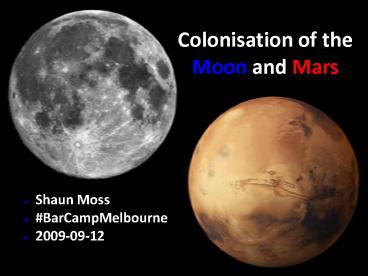Blue and Red Gradient PowerPoint PPT Presentation
1 / 18
Title: Blue and Red Gradient
1
Colonisation of the Moon and Mars
- Shaun Moss
- BarCampMelbourne
- 2009-09-12
2
Who Am I?
- Freelance web geek (PHP, JS, MySQL, Drupal)
- Writer, humanitarian, environmentalist.
- Space enthusiast Mars Society, Mars Foundation,
MarsDrive, NSSA, Space Frontier Foundation, Space
Renaissance Initiative - Chairman of Board of Moon Society
(www.moonsociety.org)
3
- 384,000km from Earth
- Gravity 0.17g (1/6 Earth)
- Diameter 3474km (27 Earth)
- Temp 70K-390K (-200C - 120C)
- Surface area equal to Africa Australia
- Lots of metals and oxygen
- Virtually no atmo, water, C, H, N (essential for
life) - 29.5-day diurnal cycle (2w light, 2w dark)
4
Mars
- 55-400Gm from Earth
- Gravity 0.38g (3/8 Earth)
- Diameter 6779km (53 Earth)
- Temp 186K-268K (-87C - -5C)
- Surface area equal to allland area of Earth
- Lots of water, metals, CHNOPS, etc.
- Atmo mainly CO2 _at_ about 0.7kPa
- Diurnal cycle 2440, orbital period 1.9 Earth
years
5
Why Colonise Other Worlds?
- Abundant resources (metals, carbon, energy, etc.)
- Preservation of our species (defence against
asteroid impacts) - Inventions/Engineering robotics, ISRU, LSS,
enviro-control, comms, vehicles, etc. - The Overview Effect
- Inspiration, adventure, frontier
6
Why Colonise the Moon?
- Close to Earth - short missions, rapid emergency
response, comms (1.5 light seconds)
- Science solar wind, formation of Solar System,
astronomy (far side) - Good tourist destination (sports in 0.17g)
- Great view of Earth! (60 x brighter than full
moon)
7
Why Colonise the Moon? (cont.)
- Practice for other destinations, e.g. Mars
- Resources solar energy, He-3, iron, engineering
metals (Ti, Al, Mg), PGM's - Low g good for construction, spacesuits, access
to space
- Manufacture space habitats, vehicles, etc.
8
Why Colonise Mars?
- Abundant resources, incl. water, atmo, CHNOPS,
solar wind energy ? independence from Earth
- Diurnal cycle almost same as Earth (2440)
benefits for humans, crops, etc. - Axial tilt almost same (seasons)
- Comparatively close to Earth
9
Why Colonise Mars? (cont.)
- Science astrobiology, geology, hydrology
- Transparent atmo (sky, stars)
- Potential for terraforming
- Create enlightened, high-tech, scientific,
legacy-free society.
10
Technical Challenges of the Moon
- Energy solar 50. Stored energy (vanadium
redox batteries), peaks of eternal light,
fission, fusion, H fuel cells.
- Air plenty of O, but no N import? Pure O2
explosive (Apollo 1). - Water minimal inaccessible, hard-frozen at
poles - Growing food w/o C and N? Import food, seeds,
organic material (humus), fertiliser
11
Technical Challenges of the Moon
- Long diurnal cycle artificial lighting
- Extreme T cooling and heating of bases
- Radiation (solar wind, flares) cover bases w/
dirt, underground
- Health problems caused by low g, e.g. muscle
bone loss - Meteorites
- Ubiquitous abrasive dust
12
Technical Challenges of Mars
- Energy solar, wind, geothermal, fission (no
nukes on Mars!) - Air manufacture fromMars atmo (3 N2)
- Water obtain frompermafrost, poles
- Food greenhousesw/ high-CO2
13
Technical Challenges of Mars
- Distance from Earth ? long missions (2 years),
comms lag up to 40 min, slow emergency response
- High-UV radiation cover bases w/ dirt,
underground - Spacesuit mass below 50kg
14
Financial/Political Challenges
- High cost of fuel, salaries, tech development.
- Cost of access to space (US10k/kg to LEO)
- International collaboration (ISS) spread cost
- CATS (cheap access to space). Ion, plasma
propulsion, nuclear thermal rockets, solar sails,
field propulsion, space elevator - Who owns Moon/Mars? Outer Space Treaty, space
law. - Militarisation of space, geopolitical climate
15
Space Business
- NewSpace a.k.a. Space 2.0
- Tourism flights into space,orbital and lunar
hotels - Sport
- Metalliferous mining (L, M, A)
- Lunar energy solar and He3
- Property development
16
Terraforming Mars
- Increase T orbital mirrors/lenses, greenhouse
gases (PFC's) - Increased CO2 H2O ? increased T (runaway
greenhouse effect) ? new equilibrium at higher T - Liquid water ? aquatic life (algae,
cyanobacteria, etc.). Water provides protection
from UV.
17
Terraforming Mars
- Photosynthesis converts CO2 atmo to O2
- N2 imported from Venus or Titan ? Earthian air
- High O2 ? ozone layer (O3) ? protection from UV
- Ozone layer wet weather ? life on land
- Genetic engineering DNA from extremophiles,
extant martian life - Robotic gardeners
- Planet-circling conductor ? artificial
magnetosphere ? radiation protection
18
The End
- Mars Society marssociety.org
- MSA marssociety.org.au
- Moon Society moonsociety.org
- Space Frontier Foundationspacefrontier.org
- Email me shaun_at_starmultimedia.biz
- Coming soon!

